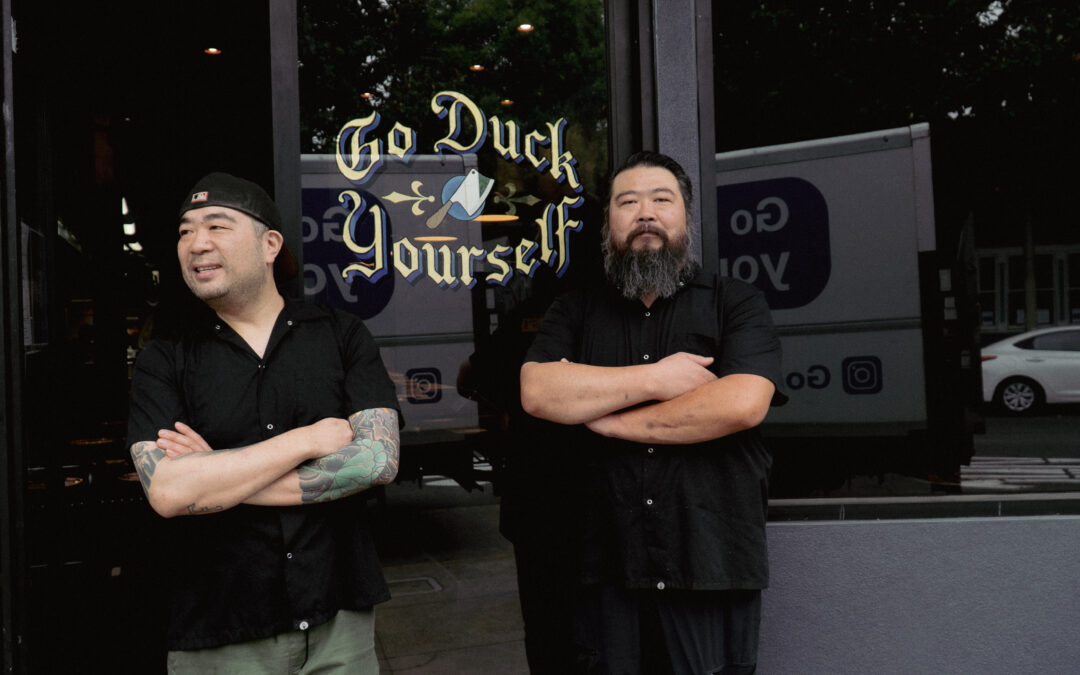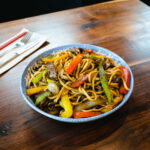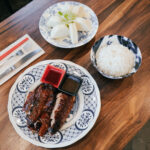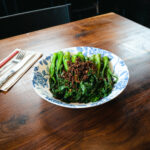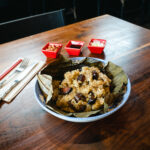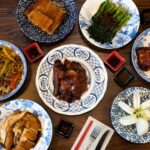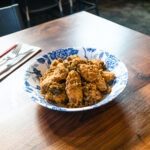Recently, we had the chance to learn more about Go Duck Yourself, a culinary gem nestled in the heart of Bernal Heights, San Francisco. This family-owned establishment combines the rich flavors of Cantonese roast duck with innovative Teochew-inspired dishes, creating a unique dining experience that honors tradition while embracing creativity.
GO DUCK YOURSELF was born during the peak of the 2020 lockdown by the renowned Cantonese barbecue staple, Hing Lung Company.
Hing Lung Company first opened in the late 1970s. Our father, Wing Cheung, was part of the original crew after our family immigrated from Hong Kong in the early ’80s. Hing Lung Company is proud to be a small, family-owned San Francisco Legacy Business.
Brothers and chef-owners Eric and Simon are passionate about highlighting the beloved comfort food they grew up with while also elevating the perception of Chinese cuisine.
Go Duck Yourself offers an intimate, dine-in setting where guests can savor meticulously prepared signature dishes like their famous Cantonese roast duck, alongside new menu items that showcase the diverse heritage of Chinese cuisine. With its playful name, community-focused approach, and commitment to quality, Go Duck Yourself invites food lovers to embark on a flavorful journey that celebrates the best Hong Kong barbecue and Teochew culinary traditions.
- Good Ducking Noodle
- GDY Cantonese Roast Duck 燒鴨
- Stir Fried Greens 蒜炒油菜
- Sticky Fried Rice
- Family, Tradition, and Innovation: The Story Behind Go Duck Yourself
- Im-peck-able Wings 无可挑剔鸡翅膀
Family, Tradition, and Innovation: The Story Behind Go Duck Yourself
What inspired you to open Go Duck Yourself in Bernal Heights, and how does it differ from your previous restaurant, Hing Lung?
Our family has long been fond of Bernal Heights, especially since one of our sisters lived in the neighborhood. We frequented the area when our kids were little. We loved visiting Bernal for storytime at the library, having lunch at Taco Los Altos, United Dumpling, and picking up sweets from Little Bee Bakery (now Bernal Basket). We also have many date nights with friends at 3rd Cousins.
We were immediately interested when the space at 439 Cortland Ave was listed on the market. We sought an environment that contrasts with the bustling downtown operation and a location that is more accessible for our customers from the Peninsula. This space was empty and raw, allowing us to build from scratch. We aim to provide a dine-in experience distinct from Hing Lung’s deli setup.
Can you explain the process of preparing your signature Cantonese roast duck? How does it differ from the Peking duck?
Cantonese roast duck is a dish from the southern region of China, while Peking duck originates from the north, specifically Beijing. Their preparation, cooking methods, and serving styles are very different.
Cantonese roast duck requires multiple steps. The duck is butchered in a way that allows its abdominal cavity to be stuffed with spices and then sealed with a single skewer. The sealed duck is blanched in boiling water and immediately dipped into a vinegar-maltose mixture, which helps the skin brown evenly during roasting. The type of vinegar and its ratio to maltose is a closely guarded recipe. The duck is then air-dried in a temperature- and humidity-controlled cooler for 24 hours before roasting. During roasting in specialized ovens, the chef rotates the duck every five minutes to ensure even cooking. After about 45 minutes, the duck is removed and hung to rest for at least 30 minutes.
When it’s time to serve, the skewer is removed, and the duck’s juices, collected inside the sealed abdominal cavity, are drained and used as a dipping sauce—or duck au jus. While most Cantonese roast ducks are chopped bone-in, we take the extra step to debone our ducks while keeping the skin attached to the tender meat. This makes it easier for customers to enjoy the duck in Baos without worrying about bones.
Peking ducks are prepared by inserting a needle between the skin and meat, inflating the skin with air to separate it from the rest of the duck. It is then blanched and dipped in the vinegar-maltose mixture, similar to Cantonese roast duck, but air-dried for several days to achieve super crispy skin. However, this process can leave the meat tough, dry, and chewy. For this reason, Peking duck is served thinly sliced by a skilled carver, while Cantonese duck is served in large, juicy chunks.
Peking duck is typically served with just the skin and a little meat, wrapped in a thin crêpe with sliced scallions. Its flavor relies heavily on sweet bean paste. In contrast, Cantonese roast duck can be enjoyed on its own, offering a satisfying balance of crispy skin and juicy meat.
Cantonese roast duck focuses on flavor, texture, and a balance of crispy skin and juicy meat, while Peking duck emphasizes crispy skin and knife skills, which can drive up its price.
What new menu items have you introduced at Go Duck Yourself that weren’t available at Hing Lung?
To introduce ourselves to the surrounding Bernal area, we offer all the popular items that Hing Lung Company was known for, including roast duck, BBQ pork, and crispy pork. Very soon, we will slowly integrate some Teochew flavors, such as a cold appetizer dish like marinated beef shank and a light, airy oyster fritter.
How did you come up with the name “Go Duck Yourself,” and what has been the public reaction
How “Go Duck Yourself” was born is pretty comical. I’m sure every spouse/partner can relate to this story. In 2020, after a long day of working remotely, juggling three kids’ distance learning, dropping off food to elderly family members, and long lines at the supermarket because of the lockdown, I came home to a messy house with the kids asking for homework help. Meanwhile, Eric was in his mancave playing video games and had the audacity to text me, “What’s for dinner?” My immediate response was, “Go F@#& yourself. I’m not cooking tonight.” But autocorrect changed it to “Go Duck Yourself,” which made us all laugh. We realized it would be a catchy name for our new delivery platform. It’s not something you’d forget easily.
The name has an attitude and humor, and, of course, we specialize in duck. Many of our customers “get it, ” love the name, and often share their “duck” puns and jokes. However, we get a few negative remarks from people who don’t quite understand the humor and vow to boycott our business…. FYI, our Chinese name also works the same way. It’s like this was meant to be.
I have heard of plans for “date night” specials. Can you elaborate on some of the unique dishes you plan to offer?
We have a unique item that will be launched later this year—Disco Duck. Just imagine our flavorful roast duck served with crushed candies. There’s also a lemon duck, which uses salted lemons as a stuffing. Chef Eric will name it “Lemon Duck You a little bit.” So now you know why it’s only for date night. These two roast ducks will elevate your taste buds to a whole new level. They will only be available via reservation.
How have you incorporated the local community into your new restaurant, particularly in design and artwork?
We focused on working with San Francisco-based builders and artists throughout the process. We met and interviewed many talented individuals, and somehow, the energy of 439 Cortland Ave guided us toward our Bernal neighbors.
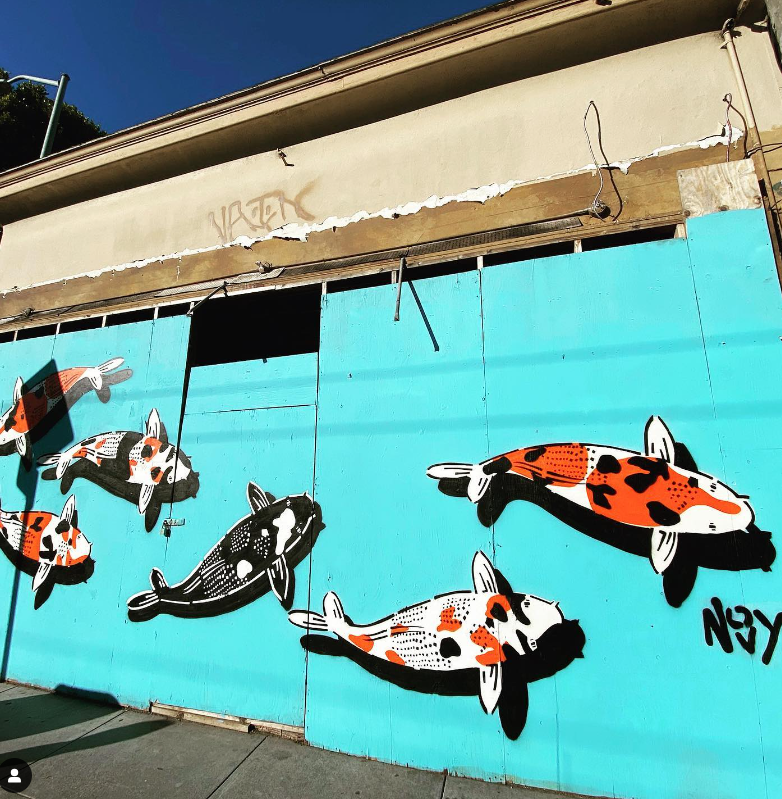
Go Duck Yourself Koi
Do you know who is behind the Koi fish art you see around San Francisco? It’s Jeremy Novy, a Bernal Heights resident. When our site was under construction, the boards were heavily tagged with graffiti, but Jeremy graciously transformed them with his signature butterflies and Koi fish. Naturally, when it came time to plan a mural for the Wool Street wall, we wanted Jeremy to create it. He immediately envisioned a mural honoring the architectural history of Bernal Heights, highlighting everything from the hills and earthquake shacks to Edwardian Arts and Crafts cottages and modern designs. Together, Jeremy Novy and Josh Katz, with the support of many neighbors, completed a mural that beautifully commemorates Bernal’s rich history.

Go Duck Yourself Mural
For the interior, I remember discovering architect Andre Rothblatt online because of the vision we had in mind. When I called him, he asked, “Bernal? Bernal where? I’ll be there in 5 minutes.” Finding out he was a neighbor felt like a sign. Through Andre’s artistic direction, we connected with other local talents, including Jim Misner, who designed our light fixtures; David from FYRN in Potrero Hill (also a Bernal resident); and Anastasia Faiella, who took care of the decorative details. Jason Lees also added a special touch by handcrafting all the wood countertops and the dining room bench, giving the space an organic and warm feel.
What challenges did you face in opening Go Duck Yourself?
From day one of acquiring this space, we faced numerous challenges. We encountered lockdowns, delays in responses from city permitting offices, supply chain issues, and increased costs of goods. However, the biggest challenge was the property’s structural condition. Although we knew previous owners had made no improvements, we did not anticipate just how poor the condition was. We had to invest additional time and funds to work with the city and rebuild the space from scratch. The entire project took three years to complete.
Can you tell us more about the Teochew dishes you’re offering and why you decided to include them on the menu?
Although the brothers were born in Hong Kong and the family resided there for one generation, proudly calling Hong Kong Cantonese cuisine their own, they can never forget the comforting tastes crafted in their mother’s and grandma’s kitchen—the flavors of Teochew.
Our 94-year-old grandmother proudly claims that Teochew is the origin of many other Asian cuisines. According to her, the famous Taiwanese oyster pancake originated from Teochew, a style of cooking introduced to Taiwan by Teochew migrants during the Sino-Japanese War. Many marinated and dipping sauces in Southeast Asia are from the traditional sauce – Teochew fermented fish sauce.
Teochew (pronunciation in Cantonese) / ChaoZhou (pronunciation in Mandarin) cuisine originates from the Chaoshan region in eastern Guangdong, China. While Teochew and Cantonese cuisines share some similarities, they differ significantly in their culinary traditions, ingredients, and flavors.
Teochew cuisine is known for its light, fresh flavors, skilled poaching techniques, use of preserved ingredients, balance of sweet and savory elements, and emphasis on shellfish dishes. At Go Duck Yourself, we combine the essence of Teochew flavors with Hong Kong Cantonese BBQ. We are introducing a cold sliced beef dish marinated in a light but aromatic Teochew sauce. Our soy-marinated chicken showcases the technique of poaching, and we are launching two dishes that highlight the sweet and savory combinations typical of Teochew cooking. Preserved ingredients like Chinese sausages and cured fatty pork are featured in our sticky fried rice, and soon, we’ll be offering a light and flavorful oyster fritter.
Most Bay Area Chinese restaurants focus on Northern or Cantonese flavors, but we aim to spotlight the unique qualities of Teochew cuisine.
How do you balance maintaining traditional recipes and techniques with innovation in your cooking?
In today’s culinary world, countless new tools, gadgets, and technologies aid production. At GDY, we’ve adapted some of these to support our kitchen staff with timing and safety. We are trained in traditional methods, relying on our senses and touch, and maintaining traditional recipes remains essential to us.
Where can folks learn more?
To learn more about Chaoshan cuisine: Netflix’s flavor origin – Chaoshan cuisine.
To learn more about GO DUCK YOURSELF – follow us @go_duck_yourself_sf

